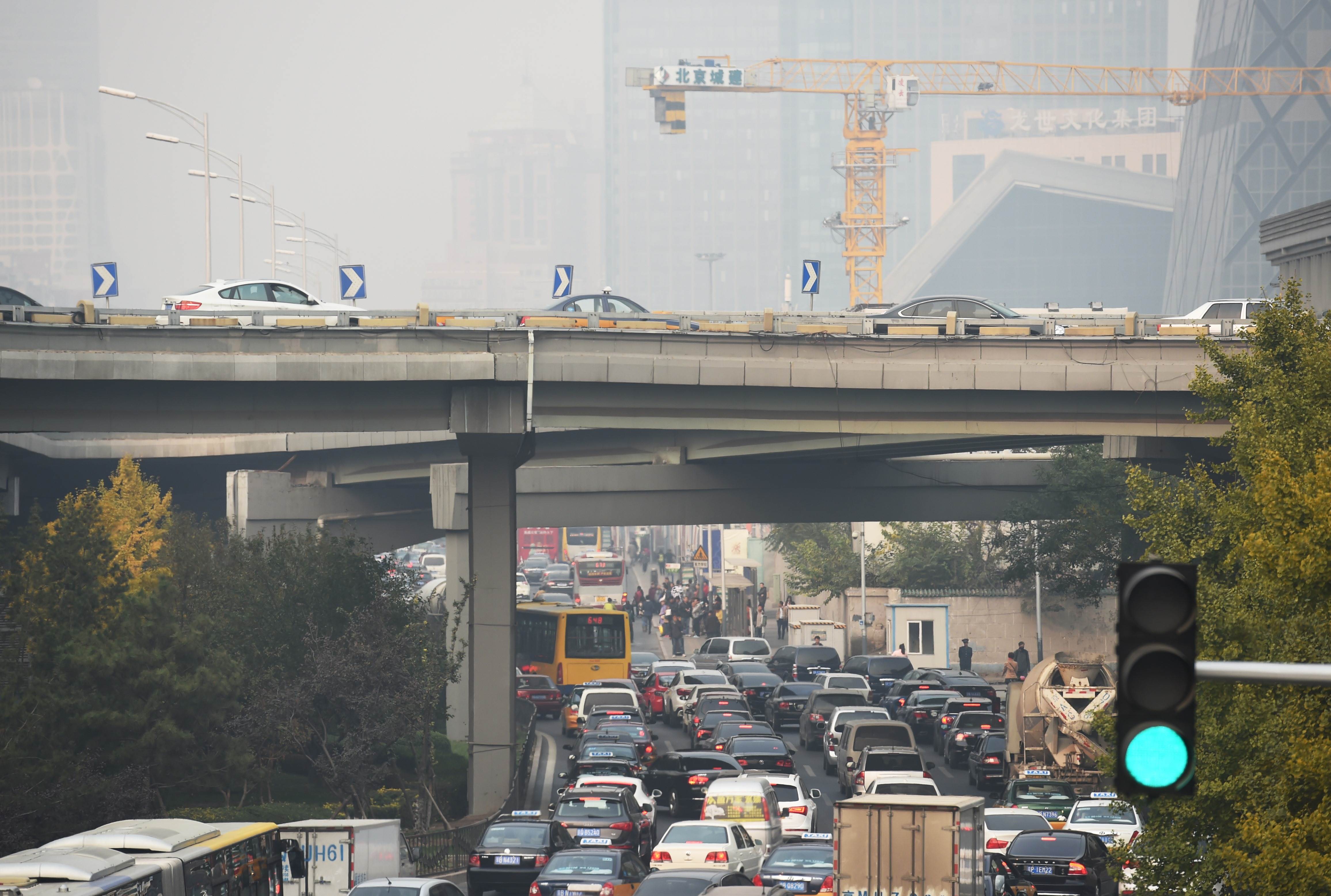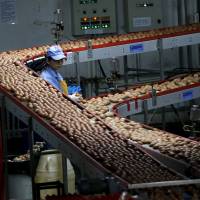To get a sense of how hard it is to measure greenhouse gas emissions in China, it pays to visit the Deqingyuan poultry farm on the outskirts of Beijing, where streams of chicken manure are piped from wooden sheds to an industrial gas digester that rises above the ground like a tethered balloon.
Turning waste into kilowatts qualifies Deqingyuan for valuable carbon credits under a U.N.-backed scheme known as the Clean Development Mechanism. The digester turns all that chicken slurry into natural gas, powering a nearby electricity station and supplying fuel to 39 surrounding villages.
Yet calculating those emissions requires a 54-page, U.N.-certified rule book, a methodology that factors everything from the amount of methane removed from the manure to local temperatures and animal weight to come up with a figure.
And that cumbersome process can mean Deqingyuan's emissions savings vary wildly — sometimes by as much as 20 percent.
"I don't know how they calculate the figure but there were many researchers from universities who came to assess it," said Vincent Wei, a marketing manager at Helee Bio-Energy Technology, which built the plant.
Precise data collection is a tricky business everywhere, as the Volkswagen scandal over discrepancies between the German auto company's emissions claims and the real world performance of its engines has shown.
But getting accurate emissions data is crucial for governments seeking a global climate accord in Paris this December. Negotiators say that, to succeed, any agreement must be built upon "measurable, reportable and verifiable" statistics in order to assess whether countries are on track to meet their emissions targets.
And getting a better grasp of the right numbers is particularly crucial in the case of China, which is widely assumed to be the world's largest carbon emitter. China's energy use is so great that even minute errors in data can translate into a difference of millions of tons of emissions.
No one currently knows how many tons of carbon China emits each year. Its emissions are estimates based on how much raw energy is consumed, and calculations are derived from proxy data consisting mostly of energy consumption as well as industry, agriculture, land use changes and waste.
Many outside observers view the accuracy of those figures with skepticism.
"China's contribution (to the global climate plan in Paris) is based on CO2 emissions but China doesn't publish CO2 emissions," said Glen Peters, senior researcher at the Center for International Climate and Environmental Research in Oslo. "You're left in the wilderness, really."
Demands for better data played a major role in the failure of the 2009 Copenhagen conference, when China and several developing nations balked at providing the rest of the world with detailed data, claiming it would be an intrusion on their sovereignty.
The last time Beijing produced an official figure was in 2005, when it said its emissions stood at "approximately" 7.47 billion tons. And while it has promised that emissions will peak by 2030 at the latest, experts say the statistical uncertainty is so great that forecasts on what that peak means can vary from 11 billion to 20 billion tons a year.
That margin is greater than the entire annual carbon footprint of Europe.
At the moment, no country has the technology or the budget to completely track exact greenhouse gas emissions in real time.
The International Energy Agency and other energy organizations operate a centralized reporting and analysis system using unified statistical methodologies and reporting schedules.
The European Union's emissions trading market, for example, also operates mainly on estimates based on the amount of carbon in energy burned. But the Europeans say monitoring and measurement of the roughly 11,000 power stations and industrial plants in 31 countries that comprise the system are stricter than what occurs in developing nations.
"Every single source that could have emissions connected to it has to be identified and controlled," said Halvor Molland, director of information at Norwegian aluminium producer Norsk Hydro which also follows U.N. guidelines and says its numbers are verified by outsider companies.
"Even if we have a fire drill and we use diesel to set a small fire we have to calculate the amounts," he said. "These are chemical reactions so we know that if you set fire to one liter of diesel you know how much carbon will come out."
China's data reporting is managed by hundreds of organizations, and the methodologies and data at the local government and industry level often conflict with the country's National Bureau of Statistics. For example, coal production data accumulated from 26 provincial governments in 2013 was 500 million tons more than the NBS report of 3.65 billion tons.
There are different understandings about which firms should be monitored. Small-scale businesses that fall below the NBS threshold are routinely excluded from calculations, and many small, illegal coal mines conceal their production in order to avoid shutdowns.
Apart from Russia China is the only country to use raw coal production rather than sales to calculate overall output, which fails to account for the losses that accrue during processing and transportation and also ignores waste products like gangue, which could account for around 18 percent of raw coal output.
These gaps could mean that China's emissions are actually being overestimated, a government researcher said.
All this riddles the system with imperfections. A study published last month by the magazine Nature suggested China's emissions could have actually been exaggerated by as much as 14 percent because of faulty assumptions about the quality of China's coal.
Bureaucratic rivalries also lead to clashing data. Climate negotiations are run from the National Reform and Development Commission, which determines what data to publish.
"All the emission estimates officially come from the NDRC rather than from the statistics bureau," says Dabo Guan, a professor of climate change economics at the University of East Anglia. "The NDRC is in charge of the whole climate change negotiations and they have to fight for the best position for China, so they have their concerns about what can and cannot be published."
"The Chinese government likes to hold authority over data for fear that different numbers than those from official sources could lead to social unrest," says Angel Hsu, a professor with the Yale School of Forestry and Environmental Studies, who has researched the poor quality of Chinese data.
"China claims they don't have the human capacity to maintain and run the monitors," she says. "But they were monitoring air quality for over a decade; they just didn't release it because they were worried that it would lead to social unrest."
Officially, China says it recognizes the need to produce better data. It promised the United Nations in June to train auditors to collect better data and to produce "regular" national carbon numbers.
"The Chinese government has been funding studies into the carbon inventory — it needs to know its real level of emissions in order to reduce it," said Xi Fengming, a researcher with the China Academy of Sciences who has spent the last six years researching the country's total carbon levels.
Xi says China had made great strides since 2012 to improve the way its numbers are collected, including crackdowns on illegal coal production and the statistical fraud by energy-intensive enterprises. It has been experimenting with drones to detect carbon dioxide buildups in urban areas, and has launched pilot projects to measure energy consumption levels in real-time at industrial facilities.
Researchers say that measuring emissions from the energy sector, which amount to around 70-80 percent of China's total, is critical to getting a good overall picture of the country's overall emissions.
"If China's energy data is good, then the carbon data will be more or less accurate," said Xi.
Another impetus for improvement is China's impending cap and trade carbon market, which the country has promised to create by the end of 2017: markets require accurate baselines and data to operate properly. Some observers blame the failure of China's attempt a decade ago to create an emissions market — this one in sulfur permits models on the U.S. sulfur market — on the lack of accurate acid rain data.
Getting there remains a daunting task.
"There are more than 30 provinces and 2,000 cities and we need more companies to do third-party work and more specialist staff at companies who know how to report the data," said Xi.
And real-time emissions monitoring is unlikely — in even the medium-term.
"So far there is no regulation to force companies to install direct GHG monitoring devices on site and I don't think that will be the trend any time soon," said Richard Mao with the Environomist carbon consultancy in Beijing.
In that regard, China faces the same constraints as the world's leading economies in the West.
"It may," Mao says of the technology needed to get it right, "just be too costly."





















With your current subscription plan you can comment on stories. However, before writing your first comment, please create a display name in the Profile section of your subscriber account page.